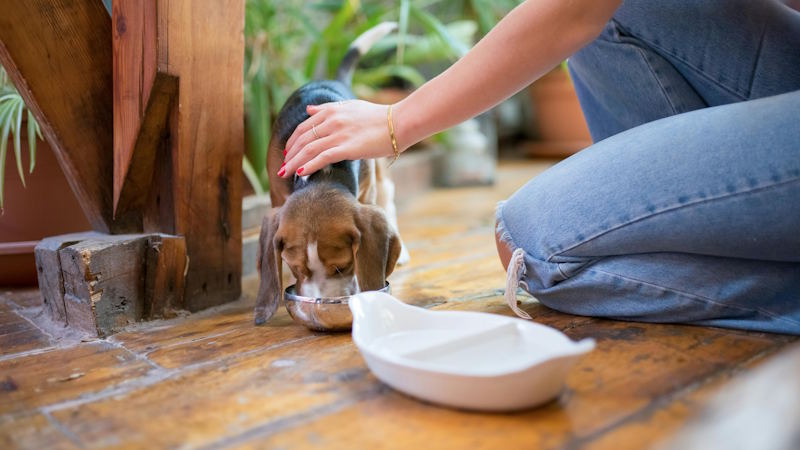
Beagle lovers, you’re in for a treat. Beagle dogs are bundles of energy with noses that never quit and hearts full of mischief. They’re small in size but big on charm, with a bark (and a howl) that demands attention.
Whether they’re chasing scents in the backyard or cuddling on the couch, Beagles bring a mix of goofiness and loyalty that’s hard to beat.
This guide dives into everything you need to know—from grooming and health to training tips and personality quirks. If you’re thinking of adding a Beagle to your life, you’re about to meet your new best friend.
Basic Characteristics of the Beagle Dog Breed
Before diving into the personality and quirks of the Beagle, it helps to understand the basics. From size and coat type to lifespan and activity needs, these core traits shape everything about how a Beagle lives, behaves, and fits into your family. Here’s a quick snapshot of what makes this breed tick.
| Trait | Details |
| Breed Group: | Hound |
| Size: | Small to Medium |
| Height: | 13–15 inches (33–38 cm) |
| Weight: | 20–30 lbs (9–13.5 kg) |
| Coat Type: | Short, smooth, dense |
| Coat Colors: | Tricolor, Lemon & White, Red & White |
| Life Expectancy: | 12–15 years |
| Temperament: | Friendly, Curious, Outgoing |
| Activity Level: | High – requires daily exercise |
| Trainability: | Moderate – intelligent but stubborn |
| Good with Children: | Yes |
| Good with Other Pets: | Yes, especially when socialized early |
| Grooming Needs: | Low – weekly brushing, ear cleaning |
| Barking Level: | High – vocal breed |
| Common Health Issues: | Obesity, Ear Infections, Hypothyroidism |
Beagle Dog Breed: The History
The Beagle’s story goes way back—so far, it’s practically ancient. Some believe their ancestors were trotting alongside hunters in ancient Greece as early as the 5th century BCE. Fast forward to medieval England, and you’ll find early Beagle-type dogs helping nobles track hare on horseback. These early versions were smaller, often small enough to fit in a pocket—hence the name “Pocket Beagle” at the time.
In the 1800s, British breeders refined the modern Beagle, focusing on its scenting ability, endurance, and size. They weren’t just making a cuter dog—they were creating a compact powerhouse for rabbit and hare hunting. Their smaller stature allowed them to maneuver through thick underbrush, following scent trails for miles without tiring.
The Beagle crossed the Atlantic in the late 1800s, where American breeders fine-tuned the version we know today. By the 20th century, the Beagle had won over not just hunters, but families and dog lovers everywhere.
Today, the Beagle is one of the most popular breeds worldwide—not for its hunting skills, but for its charm, heart, and timeless appeal.
Physical Characteristics and Size

Beagles might be small, but they’re built like little tanks. Their bodies are compact, sturdy, and full of muscle—ready for action at a moment’s notice. Everything about a Beagle screams “purpose,” from their arched neck to their strong hindquarters.
They typically come in two height varieties:
- 13-inch Beagles, which stand under 13 inches tall and weigh around 20–25 lbs.
- 15-inch Beagles, slightly taller, reaching up to 15 inches and weighing up to 30 lbs.
Despite the size difference, both types share the same athletic build and joyful swagger.
Beagles have a short, smooth coat that lies close to the body and feels sleek to the touch. Common color combos include tricolor (black, white, tan), lemon and white, and red and white. Their coats may look simple, but they shed year-round.
What really gives them their charm? Those long, droopy ears and big, expressive brown eyes that practically beg for treats. Their tail, carried high like a flag, is usually tipped in white—so hunters could spot them in tall grass.
They may look soft and cuddly, but make no mistake—Beagles are built for stamina. They’re agile, alert, and always ready to follow their nose.
Temperament and Personality

Beagles are walking bundles of joy—with a side of mischief. These dogs are as affectionate as they are energetic, always ready for a cuddle or a chase. They’re the type of companions who’ll follow you from room to room, tail wagging like it’s powered by a motor.
At their core, Beagles are social butterflies. They thrive on interaction—whether it’s with humans, dogs, or even cats. Isolation doesn’t suit them. Leave a Beagle alone too long, and you might come home to shredded slippers and an overturned trash can. They need company like flowers need sunlight.
Curiosity runs deep in their blood. Beagles were bred to track scents, so they’re wired to follow their nose wherever it leads. That’s not always a good thing—especially if they catch a whiff of something exciting. They’ll bolt across the yard chasing a scent trail without a second thought.
They’re also loud. Beagles are famous for their “bay”—a distinct howl that can shake the walls. It’s adorable in the woods, less so in a quiet apartment building. Still, that vocal personality is part of what makes them so lovable.
Beagles also have a bit of a stubborn streak. They like doing things their own way and aren’t always eager to please like some other breeds. But don’t confuse that with a lack of smarts—they’re sharp, just selectively obedient.
With kids, Beagles shine. They’re gentle, playful, and endlessly patient. They also do well with other dogs, especially when raised together.
In short, a Beagle is a best friend in a fur coat. They’re charming, stubborn, affectionate, and sometimes a little too clever for their own good. But that’s the magic. They keep you on your toes—and steal your heart while they’re at it.
Grooming Beagle Dogs
Beagles might look low-maintenance—and compared to some fluffy breeds, they are—but grooming still plays a big role in keeping them happy, healthy, and smelling halfway decent.
Their short, dense coat doesn’t tangle or mat, but it sheds like confetti. Especially during seasonal changes, you’ll notice fur on your clothes, your couch, and probably in your coffee. Brushing once or twice a week with a firm bristle brush helps reduce the fallout and keeps their coat looking clean and shiny.
Shedding tip: A quick five-minute brush session can do wonders. It distributes natural oils, removes dirt, and makes them look like they just walked out of a doggie salon.
Beagle ears are another story. Those long, floppy ears trap moisture and block airflow, creating the perfect party spot for bacteria. You’ll want to check and clean them weekly with a gentle, vet-approved cleanser. If they smell funky or look red inside, it’s vet time.
Don’t forget the nails. Beagles love to run, but they don’t always wear their nails down naturally—especially indoor dogs. If you hear clicking on the floor, it’s trimming time. Aim for a trim every 3–4 weeks.
Baths? Only when they’re dirty. Beagles don’t need frequent baths, but when they do get into something stinky (which they will), use a mild dog shampoo. Overbathing strips their skin of essential oils.
And then there’s dental care. Beagles can suffer from plaque buildup, so brushing their teeth a few times a week—ideally daily—is a smart move.
Grooming checklist:
- Brush coat weekly
- Clean ears weekly
- Trim nails monthly
- Bathe occasionally
- Brush teeth regularly
It’s not rocket science. But skipping these basics? That’s where problems sneak in. A little grooming time now saves vet visits (and carpet stains) later.
Training Needs of the Beagle

Training a Beagle is like teaching a toddler with a jetpack—adorable, fast-moving, and easily distracted. These dogs are smart, no doubt, but they’ve got a nose that overrules their brain most of the time.
Beagles were bred to follow scent trails for hours. That instinct still runs the show today. Once they catch a whiff of something interesting, everything else fades into the background—including your voice. That’s why recall training is critical—you need to know they’ll come back, even if a squirrel is teasing them.
Start early. Puppyhood is your golden window. Enroll them in obedience classes, expose them to people and dogs, and lay the groundwork for a well-mannered adult. Waiting too long? That’s when their stubborn streak really kicks in.
Use positive reinforcement—treats, toys, praise. Beagles don’t respond well to harsh corrections. They’ll shut down, or worse, start ignoring you completely. Keep sessions short and fun. Think mini-games instead of boot camp.
Leash training is non-negotiable. Beagles are escape artists. A squirrel or scent trail can send them bolting across the street in seconds. Teach them to heel, use a harness if needed, and practice often.
Crate training helps with housebreaking and prevents destruction when you’re not home. Beagles get bored easily, and boredom leads to chewed furniture and shredded pillows.
Here’s the kicker: Beagles are intelligent, but selective. They know what you want—they just don’t always care. So, your job isn’t just to train them. It’s to make them want to listen.
Training tips:
- Keep sessions under 10 minutes
- Always reward with treats or affection
- Practice in quiet areas first, then add distractions
Training a Beagle takes patience, humor, and a bit of strategy. But once it clicks? You’ve got a loyal, clever companion who’s ready for anything.
Health Concerns and Health Issues
Beagles are generally tough little hounds, but that doesn’t mean they’re bulletproof. Like any breed, they come with their own set of quirks and vulnerabilities.
Obesity is enemy number one. These dogs live for food. If you don’t measure their meals and limit treats, they’ll balloon faster than you can say “table scraps.” And excess weight brings a host of problems—joint pain, heart stress, and reduced mobility.
Ear infections are another common issue. Their floppy ears may be cute, but they trap moisture and debris like a sponge. If left unchecked, bacteria and yeast can set up shop. Redness, odor, or constant scratching? Time for a vet visit.
Other health risks include:
- Hip dysplasia – Uncommon, but possible. Watch for limping or stiffness.
- Epilepsy – Some Beagles suffer from seizures. Medication can help manage it.
- Hypothyroidism – Causes weight gain and fatigue. Blood tests catch it early.
- Cherry eye – A visible red bulge in the eye corner. Usually treatable with surgery.
Routine checkups matter. Your vet can spot early warning signs before they become full-blown problems.
And don’t forget preventive care—vaccines, parasite control, and dental cleanings go a long way. Keep your Beagle active, monitor their diet, and stay on top of those ears. A little attention now prevents a lot of trouble later.
Nutrition and Feeding

Feeding a Beagle is a bit like managing a tiny, furry food-obsessed roommate. They’re not just enthusiastic eaters—they’re relentless. If it smells edible, they’ll try to eat it. And sometimes even if it doesn’t.
Beagles gain weight easily, so portion control is your top priority. Don’t eyeball it. Use a measuring cup. Free-feeding is a recipe for a chunky hound and serious health issues down the road.
Adult Beagles typically do best on two meals per day. Puppies need more frequent feeding—three to four small meals until about six months old.
Stick with high-quality dry kibble designed for small to medium breeds. Look for foods with real meat as the first ingredient and limited fillers. Some Beagles also benefit from grain-free or sensitive stomach formulas—but talk to your vet before making that switch.
Feeding tips:
- Don’t feed from the table. It encourages begging and digestive upset.
- Limit treats to 10% of daily calories. Training rewards should be small and low-calorie.
- Fresh water should always be available. They need it, especially after exercise.
Watch for signs of overeating: sluggishness, bloating, or weight gain. Beagles don’t self-regulate—they’ll eat first and regret later.
If your pup seems constantly hungry, it might not be just greed—it could signal a thyroid issue or lack of nutrients. A quick vet check can clear that up.
Food is fuel, not entertainment. Feed smart, keep them active, and your Beagle will stay fit, focused, and full of life.
Lifespan and Welfare of the Beagle Dog

Beagles are in it for the long haul. With proper care, these little hounds typically live 12 to 15 years, sometimes even longer. But a long life doesn’t mean much without quality. That’s where daily habits come in.
Exercise is non-negotiable. A Beagle without activity is a Beagle headed for trouble. They need at least 45–60 minutes of movement every day—walks, playtime, or nose games that tap into their scent-tracking instincts.
Mental stimulation matters just as much. These dogs are thinkers. Puzzle toys, scent trails, and training games keep their brains buzzing. Boredom? That’s when the chewing, digging, and howling kick in.
Social needs run high. Beagles don’t do well in isolation. They’re pack animals by nature. Whether it’s people, other dogs, or just time out of the crate, they crave connection. Long hours alone can lead to anxiety or destructive behavior.
Preventive healthcare makes a huge difference. Yearly vet visits, parasite control, and regular dental care all stack the odds in their favor. Keep their weight in check, monitor their joints as they age, and don’t ignore changes in behavior.
Comfort matters too. Soft beds, shaded areas during hot days, and access to clean water all support long-term wellness.
In short, a healthy Beagle is a busy, loved, and engaged Beagle. Give them what they need—and they’ll give you years of tail wags, goofy grins, and loyal companionship.
What Makes Special the Beagle Dog Breed

What makes a Beagle special? It’s not just one thing—it’s the whole package. They’re equal parts clown, detective, and cuddle bug, all wrapped into one compact, tail-wagging body.
Start with the nose. A Beagle’s sense of smell is legendary—second only to the Bloodhound. They can track a scent trail for miles without missing a beat. That’s why they’re often used in airports and customs inspections. But at home? That same nose finds hidden snacks, lost toys, and sometimes your socks.
Then there’s the personality. Beagles are endlessly cheerful, always ready for fun. Their enthusiasm is contagious. They wake up every day like it’s the best day ever—and they want to spend it with you.
Their compact size and gentle temperament make them ideal for families. They’re small enough for apartment living but tough enough to keep up on hikes or backyard adventures.
And let’s not forget their voice. Beagles don’t just bark—they sing. That classic “Arooo!” can be hilarious or headache-inducing, depending on the time of day. But it’s part of their charm.
Beagles aren’t just pets—they’re characters. Mischievous, affectionate, brave, and goofy. Life with a Beagle is anything but boring. They may steal your snacks, but they’ll steal your heart first.
Summary
Beagles are the full package—funny, loyal, energetic, and just the right amount of troublemaker. They bring joy, noise, and a whole lot of personality into any home they join.
With their compact build and soulful eyes, they win you over before they even do anything. But don’t be fooled—behind that sweet face is a scent-driven explorer who’s always plotting their next move. They’ll follow a trail to the end of the earth—or the bottom of your kitchen trash can.
Training can be a challenge, but their intelligence and eagerness (for treats) make it manageable. They thrive on structure, affection, and daily adventures. Grooming is easy, their health manageable, and their needs clear—company, movement, and love.
Beagles fit beautifully into family life, do well with kids, and usually play nice with other pets. They’re social creatures who want to be part of the action.
If you’re looking for a dog that’s playful, affectionate, and just a little bit naughty, the Beagle might be your perfect match. They won’t just live with you—they’ll make life sweeter, sillier, and a whole lot louder.